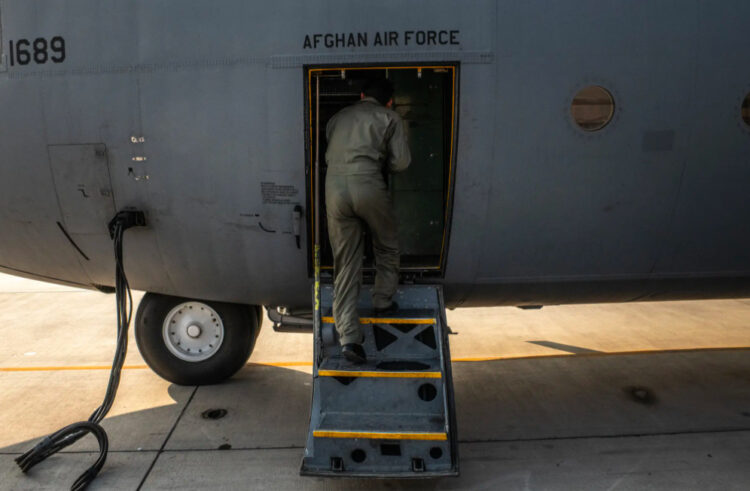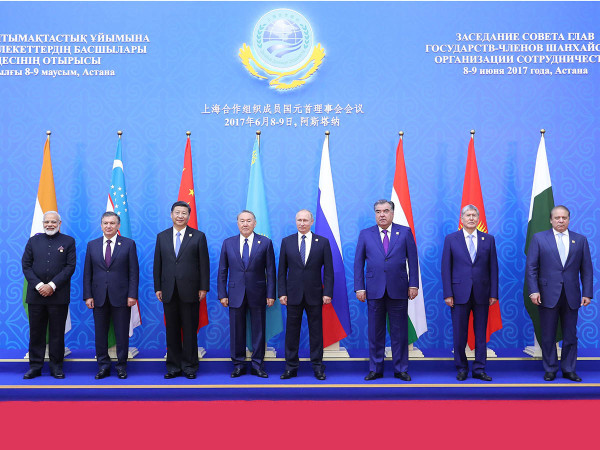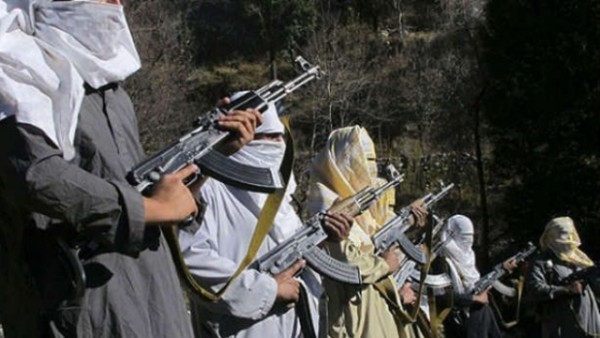MANTRAYA OCCASIONAL PAPER #09: 29 JULY 2022
SHANTHIE MARIET D’SOUZA

(Image Source: New York Times)
Abstract
In July 2021, the ministry of defense of the now deposed civilian Afghan government posted on social media photographs of seven brand new helicopters arriving in Kabul from the United States (U.S.). A few days later, U.S. Defense Secretary Lloyd Austin told reporters at the Pentagon that the Afghans will “continue to see a steady drumbeat of that kind of support, going forward.” In a matter of weeks, however, the Taliban had captured power in Kabul and had seized much of the weapons and equipment including aircraft left behind by fleeing Afghan forces. While the actual reasons for the swift and bloodless victory by the Taliban are being debated, it can be argued that the lack of adequate airpower support made a critical difference to the capacity of the civilian government and the Afghan National Defense and Security Forces (ANDSF). Had the international community acceded to the repeated demands of the civilian government and forces to build a potent Afghan air force as the mainstay for its anti-Taliban operations, the swift fall of Kabul could have been averted.
(
A Modest Air Force
Notwithstanding the stated objective to build a large Afghan army, the vision by the international community in general and the U.S., in particular, did not include a potent Afghan air force. According to the U.S. Government Accountability Office (GAO), between 2003 and 2016 the US United States provided Afghan forces with 208 aircraft. A report by the U.S.-based Special Inspector General for Afghanistan Reconstruction (SIGAR) indicated that the Afghan Air Force was operating 167 aircraft, including attack helicopters and planes, at the end of June 2021.[1] While a category-wise breakup of the aircraft is not available, only a fraction of them could have been for combat purposes. Immediately in the aftermath of the Taliban takeover, about 40 to 50 aircraft had been flown to Uzbekistan and Tajikistan by Afghan pilots seeking refuge. According to the head of the Russian state arms exporter Rosoboronexporter, the Taliban reportedly captured nearly 100 Mi-17 Hip helicopters[2], although a large number of them were believed to be not operational.
The ANDSF remained dependent on the air support provided by the U.S., with the latter using its discretion on whether to provide such support to a particular operation or not.[3] Reports suggest that such air support to the Afghan forces was available till mid-July 2021. That month, at least four air strikes were carried out on the Taliban, at the request of the ANDSF. Two strikes were meant to destroy military equipment, including an artillery piece and a vehicle, that the Taliban had taken from Afghan forces. And the other two targeted Taliban fighting positions. On most occasions, such air strikes were organised using combat aircraft based in locations in the middle east countries within the range of Afghanistan and also including warplanes aboard an aircraft carrier in the region and fighters and bombers in the Persian Gulf area.
Although the U.S. had assured the continuation of air support to the ANDSF even after the 31 August pullout, such support was to be restricted to operations against the al Qaeda and other terror groups, and not against the Taliban. The fear that an all-out affront on the Taliban using air power could displease the group and the possibility of pulling out of the peace talks may have influenced the U.S. policy decision.
From the perspective of the U.S., the ANDSF had grown over-dependent on air support and was somewhat reluctant to use the available combat aircraft themselves.[4] However, this was a simplistic explanation as the AAF was besieged with several problems throughout its existence.
Dependency Syndrome
Notwithstanding the supply of air crafts and helicopters by the U.S., maintenance issues and other shortcomings severely inhibited the AAF’s ability to help fend off Taliban advances and support Afghan soldiers on the battlefield. Till the very end, the AAF lacked fighter jets and was dependent on Cessna AC-208 Caravans and Brazilian-made A-29 Super Tucanos light attack aircraft. A significant part of the AAF’s involvement in CT operations was by using helicopters. Not surprisingly, this made the low-flying helicopters vulnerable to the insurgents and others, who had access to mortars and rocket-propelled grenades. For instance, in March 2021, four crew and five soldiers, on board the military MI-17 helicopter of the AAF, were killed after it was shot down in Maidan Wardak province in Central Afghanistan.[5] Interestingly, however, the attackers belonged to an anti-Taliban Hazara warlord Abdul Ghani Alipur. Alipur, although fiercely anti-Taliban, was a source of constant trouble for Kabul over killing, abduction, and extortion activities. Separately, AAF pilots, during media interactions, described several instances of their helicopters either being hit by bullets or narrowly missing the incoming RPGs fired by the insurgents.
Maintenance of the entire fleet of Afghanistan’s fleet of UH-60 Black Hawk helicopters and C-130 Hercules transport planes remained in the hands of the U.S. and other foreign contractors. According to a New York Times report in June 2021, the Afghan military “is heavily reliant on American and other foreign contractors for repairs, maintenance, fueling, training and other jobs necessary to keep their forces operating.”[6] This meant that the departure of the U.S. forces and the contractors made the trouble-free flying of the aircraft and choppers an impossible task. In April 2021, Gen. Kenneth F. McKenzie Jr., the head of the Pentagon’s Central Command, which oversees Afghanistan, told a Senate committee in Washington, “I am concerned about the ability of the Afghan military to hold on after we leave, the ability of the Afghan Air Force to fly, in particular, after we remove the support for those aircraft.”[7]
While disaggregated data on the total number of contractors for AAF is not available, the SIGAR report of 2020 provides the overall number of contractors, belonging to the U.S., Afghanistan, and other foreign countries. According to the report, ‘There were over 18,000 Defence Department contractors in Afghanistan, including 6,000 Americans, 5,000 Afghans and 7,000 from other countries, 40 percent of whom are responsible for logistics, maintenance or training tasks’. Understandably the contractors for the AAF were entirely from foreign countries. The U.S. did not share a particularly high opinion either on the capacity of the Afghan contractors or the Afghan military’s performance at undertaking the necessary maintenance work. According to the SIGAR, as of December 2020, the Afghan National Army (ANA) was completing just under 20 percent of its maintenance work orders, well below the goal of 80 percent that had been set. Similarly, the Afghan National Police (ANP) could carry out only 12 percent of its maintenance work against a target of 35 percent.
The answer to the question, ‘why did the U.S. fail to invest in making the Afghans capable of maintaining their aircraft?’ needs to be contextualized within the larger pattern of international aid and assistance provided to Afghanistan by the international community. Although a huge sum of assistance did flow into the country for two decades, the critical need of enabling the development of local capacities was never factored into those aid delivery mechanisms. Principal reliance on foreign experts and contractors sustained what has come to be known as the ‘Phantom aid’ phenomenon, which resulted in a large portion of assistance money returning to the donor country through the appointment of handsomely-paid experts, consultants, contractors, and sub-contractors.
A last-minute proposal to retain the foreign contractors servicing the AAF aircraft and let them continue working in Afghanistan even after the U.S. withdrawal and arrange their payment through international assistance to the Afghan government fell through due to the prevailing insecurity and also due to the fears of pervasive corruption and mismanagement. This partially explains the dramatic collapse of the security structure in Kabul in August. Many disheartened and low-morale AAF pilots had little option but to flee to neighbouring Uzbekistan and Tajikistan with their planes and choppers, rather than putting up a fight. On 15 August, the day the Taliban took over Kabul, Uzbek air defence forces intercepted and shot down an Afghan military aircraft after it entered their air space without permission. Two pilots of the plane survived the accident and were sent to a military hospital for treatment. Nevertheless, a statement by the Uzbekistan government said that 46 Afghan aircraft, including 24 helicopters, had landed in its territory. On the same day, 143 Afghan soldiers in three planes and two helicopters landed in Tajikistan.[8]
The ‘Russia’ Factor
For the past several years, the fleet of Russian Mi-17 ‘Hip’ utility helicopters formed the AAF’s backbone and was deployed in operations to transport troops, deliver ammunition to the combat troops, and also in evacuation missions. The familiarity of the Afghans with this helicopter combined with their lesser price and easy maintenance and readily available spare parts made the Mi-17, a preferred machine. A fairly large number of Afghan technicians had been trained to maintain them in flying conditions. Considering these factors, the U.S. procured 50 Mi-17 helicopters for the AAF between 2005 and 2012. The purchase was also due to an arrangement worked out by NATO as part of its efforts to foster closer Russian cooperation with the alliance.
However, in 2013, the plan to buy 30 more helicopters ran into opposition in U.S. Congress, which opposed the use of American funds for the purchase of military hardware from Russia. Even the Pentagon’s plea to let the deal go through failed. That time, the Defence Secretary, Chuck Hagel, had argued, “Easy maintenance, unsophisticated. We can get it pretty quickly. That’s the one they want.”[9] However, an audit report by SIGAR concluded that providing the rudimentary AAF with 30 more helicopters is imprudent as the latter was incapable of operating and maintaining the aircraft without significant U.S. military support.
To tide over the crisis, the U.S. had the option of procuring second-hand Mi-17s from former Soviet states, several of which are NATO members. However, it decided to supply Afghanistan with the UH-60 Blackhawk helicopters, arguing that by the mid-2030s, it could replace the entire fleet of Mi-17s, and make the Afghans fly and maintain them without the assistance from foreign contractors. Delivery of such helicopters was scheduled till June 2021, when President Joe Biden told a visiting Afghan delegation that the US would provide 37 Blackhawks and two A-29 Super Tucano fixed-wing aircraft to Afghanistan.[10]
The switch from Mi-17 to the Blackhawks was never a smooth one for the AAF. Training pilots and maintenance staff on the new machine was a daunting task. The limited number of pilots and maintenance personnel who had been trained only on the Mi-17s could never operate with ease with the Blackhawks. Worse still, with the U.S. drawdown of forces, which also included the contractors, the AAF struggled to keep its Blackhawks operational. By April 2021, the readiness of the Blackhawk fleet had dipped to 78 percent, and in the next three months, to a bare 39 percent.
Lessons Learnt
Three clear flaws are identifiable in the U.S./NATO approach toward building a capable and independent AAF. Firstly, the AAF was never allowed to have a significant combat role. The U.S., in a bid to control the pace and direction of the conflict, retained that role for itself. Secondly, the AAF’s capacities remained sub-optimal due to the U.S.’ own compulsions for switching from a predominantly Russian to an American platform. And thirdly, the abrupt and swift withdrawal of the U.S. and NATO forces, without making any emergency plan to support the AAF, put the final nail in the latter’s coffin.
Several years before the fall of Kabul, senior Afghan commanders had underlined the need for the AAF’s critical role in anti-Taliban operations, extending its mandate beyond its primary role in providing logistics, troop deployment, and participating in rescue missions. Even as the Taliban continued with their territory capturing spree and marched towards Kabul, calls were repeatedly made by the Afghan military for air support from the U.S. to halt the Taliban offensive. According to a report[11], the Ashraf Ghani government even reached out to India, seeking ‘robust air support’ to fight the Taliban. It is debatable whether the last-minute insertion of foreign air power would have made any difference to the prospect of the Taliban victory.
However, it is undeniable that the strategic planning of the AAF’s evolution had to be around its combat-centric role. While such a project would have required greater resources and effort from the U.S. and NATO countries, it would have added tremendously to the capacities of the ANDSF. As a result, the swiftness with which the Taliban overran the ANDSF’s defences possibly could have been delayed, if not prevented. The fact that the Taliban did not have access to combat helicopters and fighter aircraft would have also played on the psyche of its fighters. At one level, this may possibly have led to an escalation of the conflict, with the Taliban leadership and their sponsors seeking counter-measures and possibly, antidotes similar to the Stinger missiles that had defeated the Soviet forces in the late 1980s. On the other, the ANDSF’s capacity enhancement with the AAF’s support would have made them worthy opponents of the insurgents. The end game in Afghanistan would possibly have been different from what it is today.
End Notes
[1] Vikas Pandey & Shadab Nazmi, “Afghanistan: Black Hawks and Humvees – military kit now with the Taliban”, BBC, 29 August 2021, available at https://www.bbc.com/news/world-asia-58356045, accessed on 30 November 2021.
[2] Andrew Roth, “Taliban have captured more than 100 military helicopters, Russia says”, The Guardian, 25 August 2021, available at https://www.theguardian.com/world/2021/aug/25/taliban-capture-more-than-100-mi17-helicopters-afghan-armed-forces-russia-says, accessed on 30 November 2021.
[3] Author’s interviews with AAF personnel in Afghanistan in May 2017.
[4] “US Launched Several Airstrikes in Support of Afghan Forces”, Forbes, 22 July 2021, available at https://www.military.com/daily-news/2021/07/22/us-launched-several-airstrikes-support-of-afghan-forces.html, accessed on 02 December 2021.
[5] “Nine die as Afghan military chopper shot down in militia stronghold”, Arab News, 18 March 2021, available at https://www.arabnews.com/node/1827391/world, accessed on 29 November 2021.
[6] Thomas Gibbons-Neff, Helene Cooper and Eric Schmitt, “Departure of U.S. Contractors Poses Myriad Problems for Afghan Military”, The New York Times, 19 June 2021, available at https://www.nytimes.com/2021/06/19/world/asia/Afghanistan-withdrawal-contractors.html, accessed on 30 November 2021.
[7] “U.S. general concerned about capability of Afghan security forces”, Reuters, 22 April 2021, available at https://www.reuters.com/world/middle-east/us-general-concerned-about-afghan-security-forces-after-troop-withdrawal-2021-04-22/, accessed on 01 December 2021.
[8] “Uzbekistan shoots down fleeing Afghan military plane”, Anadolu Agency, 16 August 2021, available at https://www.aa.com.tr/en/asia-pacific/uzbekistan-shoots-down-fleeing-afghan-military-plane/2337012, accessed on 01 December 2021.
[9] “Congress fuming over U.S. purchase of Russian helicopters for Afghanistan”, Washington Post, 12 July 2013, available at https://www.washingtonpost.com/world/national-security/congress-fuming-over-us-purchase-of-russian-helicopters-for-afghanistan/2013/07/12/33aecde0-ced0-11e2-8f6b-67f40e176f03_story.html, accessed on 30 November 2021.
[10] “US to provide 37 Black Hawk helicopters, 2 A-29 Super Tucano to Afghanistan”, ANI News, 30 June 2021, available at https://www.aninews.in/news/world/asia/us-to-provide-37-black-hawk-helicopters-2-a-29-super-tucano-to-afghanistan20210630210656/, accessed on 02 December 2021.
[11] Nayanima Basu, “Afghan govt wants IAF support to crush Taliban as fighting worsens across the country”, The Print, 10 August 2021, available at https://theprint.in/diplomacy/afghan-govt-wants-iaf-support-to-crush-taliban-as-fighting-worsens-across-the-country/712182/, accessed on 02 December 2021.
(Dr Shanthie Mariet D’Souza is the President and Founder of Mantraya. She is currently a Visiting Fellow in the Research Division Asia at the German Institute for International and Security Affairs (SWP), Berlin. She has conducted field research in various provinces of Afghanistan for more than a decade. This article was originally published in the Journal of College of Air Warfare, India, April 2022. It is republished as part of Mantraya’s ongoing “Mapping Terror & Insurgent Networks” and “Fragility, Conflict & Peace Building” projects.)
CLICK BELOW TO DOWNLOAD A PDF COPY.



